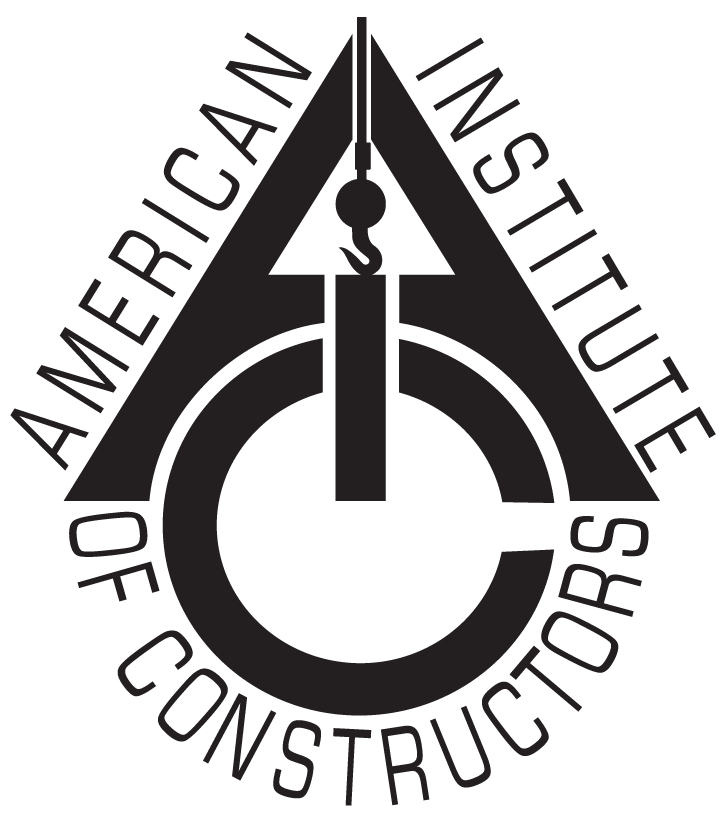This CE Center article is no longer eligible for receiving credits.
The Solution: Chemistry
Each of the causes of concrete deterioration that we have discussed can produce aesthetic, functional or structural problems if not treated properly or addressed ahead of time. To overcome these problems, there are several approaches. A common one is to use a surface coating in response to the need to waterproof the concrete to keep not just water out but chemicals and other substances too. Such solutions are based on applying a protective coating over the concrete after it is fully cured. While there are certainly some good and well-known products available for this, with the exception of crystalline technology coatings, their inherent limitation is that they are not integral to the concrete—they are all an applied layer on top of it. This means their success is entirely dependent on their adhesion to the concrete surface to prevent it from separating and peeling off, leaving the concrete exposed. They also require ongoing maintenance to be sure that the coating remains intact and continues to protect the concrete over time.
Chemical admixtures are another approach to address the properties and capabilities of concrete. They are an integral solution generally regarded as a superior approach that has been used for decades to improve the performance of concrete in a variety of ways. Their first widespread use was to extend the temperature range that concrete could be poured without fear of freezing. They also became common to improve the workability of concrete through plasticizers that allowed less water in the mix, while still retaining adequate slump (formability). Building on this proven success, it is possible to combine careful attention to the mix of concrete ingredients with appropriate chemical admixtures that can yield solutions to overcome deterioration challenges. This is particularly true through the use of admixtures that employ crystalline technology to achieve some impressive results.

A scanning electron microscope image of crystalline formation in a concrete pore shows its ability to fill and plug the voids inherent in concrete.
Crystalline Technology: What It Is and How It Works
Crystalline technology takes advantage of the natural and porous characteristics of concrete. With water as the catalyst, specific chemicals are used that react with the natural by-products of cement hydration (calcium hydroxide, mineral salts, mineral oxides, and unhydrated and partially hydrated cement particles). This reaction forms a nonsoluble crystal that grows to form a web-like crystalline structure within the interconnected pores and other voids in concrete. In this way, the crystalline structure becomes a permanent, integral part of the concrete itself. Because it is nonsoluble, it fills the voids, cracks, capillaries, pores and other openings to make the concrete impermeable, thus preventing the ingress of water and other liquids even under strong hydrostatic pressure. That means it also protects against liquid-borne chemicals that can deteriorate concrete or corrode steel reinforcing, even in harsh, aggressive environments.
When a cement particle hydrates, the reaction between water and the cement causes it to become a hard, solid, rocklike mass. The reaction also generates chemical by-products that lie dormant in the concrete. Crystalline technology adds another set of chemicals to the mixture. When these two groups, the by-products of cement hydration and the crystalline chemicals, are brought together in the presence of moisture, a chemical reaction occurs, which produces a new nonsoluble structure in the capillaries, micro-cracks and shrinkage cracks that are found in the concrete. By means of the crystalline reaction, the porosity of the concrete is plugged, and the ability of water or water-borne chemicals to penetrate the substrate is prevented.
Integral crystalline technology products are manufactured in the form of a dry powder compound consisting of portland cement, very fine treated silica sand and selected chemicals. It is the chemicals that react with the by-products of cement hydration to produce the nonsoluble crystalline formation. Specific formulations are produced for application either as a coating material, concrete admixture or dry shake product. It can be incorporated into a structure as it is being constructed or later on in the life cycle as a maintenance material that will further enhance its durability.
Crystalline Technology: What It Does
Scanning electron microscope images have provided a closeup view of how newly formed crystalline structures bridge and seal the capillary tracts and cracks in concrete. This directly reduces the diffusion of liquids and aggressive substances into the concrete and significantly extends the life of the structure. As such, crystalline technology has been shown to provide the following characteristics:

The integral capabilities of crystalline technology mean that the entire concrete structure is protected and made resistant to water and other penetrating substances.
- Provides Integral Concrete Waterproofing: Crystalline technology is an integral solution for reducing the permeability of concrete. When it reacts with the by-products of cement hydration to produce a nonsoluble crystalline structure, it blocks up the voids, openings, and other paths or passages that define the typical porosity of concrete. By plugging the pores, capillary tracts and micro-cracks with a crystalline formation, the diffusion of liquids and gases is significantly reduced, thus protecting concrete structures against effects of water penetration, including freeze-thaw cycles and water borne chemical attacks. Further, since all causes of deterioration need these paths and passages in order to diffuse into the concrete, their blockage defends against other attacks as well.
- Resists Acid Attacks: Concrete can be attacked by acidic or caustic materials, as we have seen. Acids in liquid form attack concrete by penetrating the concrete through its inherent capillary porosity as well as micro- and macro-cracks. Once inside concrete, the acid reacts with calcium hydroxide to form a calcium salt, which is easily separated from the cement resulting in a weakened paste structure. Once all of the calcium hydroxide is consumed, the acid will then attack the calcium silicate hydrate, which is the true cementing mechanism holding all of the aggregates together, and this can cause substantial structural damage to concrete. By using crystalline technology to block up the capillaries and pores of the concrete to begin with, these acidic chemical reactions and deterioration of concrete are significantly reduced.
- Resists Sulfate Attacks: Similarly, by using crystalline technology to waterproof the concrete and decrease its permeability, the amount of sulphate ions that can diffuse into the pores of the concrete is greatly diminished. When the sulphates are restricted from entering the concrete, sulphate attack is reduced, while the resistance and durability of the concrete is increased. It is also worth remembering here that the reactive chemicals in crystalline technology combine with various calcium compounds in the concrete. These calcium compounds are given off as by-products of cement hydration and are a primary building block for sulphate corrosion. By reacting with calcium hydroxide and turning it into a nonsoluble complex, the crystalline technology limits the amount of free CH available for the initial sulphate reaction. This has a direct effect on reducing the rest of the sulphate corrosion process.
- Inhibits the Effects of Carbonation: Crystalline formation in the capillary tracts has been shown to reduce not only water but also the flow of gases into concrete. Since carbonation is dependent on CO and CO2 penetrating the surface of the concrete, particularly in humid applications, crystalline technology significantly retards the carbonation process.
- Reduces Chloride Ion Attacks: A common problem for marine structures, bridges and concrete structures along roadways in cold climates is chloride attack, which occurs when chloride ions reach the steel reinforcement via interconnected pores and cracks in the concrete. Once the chloride ions have reached a critical concentration level, they are able to break down the naturally passivating alkaline film surrounding the steel and form an electrochemical corrosion cell. This results in the breakdown of the steel and the formation of rust, which occupies a larger volume than the original steel and ultimately weakens the structure. Crystalline waterproofing has been shown to reduce the diffusion of chlorides in concrete structures by preventing liquids carrying chloride ions from ever reaching the steel. This helps protect reinforcing steel and prevents deterioration that could occur from oxidation and expansion of steel reinforcement.
Concrete is known for being a strong and versatile material and is used in many cast-in-place and precast structures for a variety of infrastructure and engineering applications. However, in standard formulations, it also has some known limitations when subjected to harsh conditions. Those conditions can cause physical damage or deterioration of the concrete, leading to significant problems and shortening the useful life of the concrete structure. The use of chemical admixtures in the concrete mix can help change the nature of the concrete and overcome some of those limitations, particularly deterioration. In specific admixtures, the use of crystalline technology has been shown to be quite effective in terms of waterproofing the concrete and providing resistance to chemicals, extreme temperatures and other conditions. Engineers who recognize the causes of concrete deterioration along with the best options to overcome them can create resistive concrete components that are more durable and more sustainable in the long run.
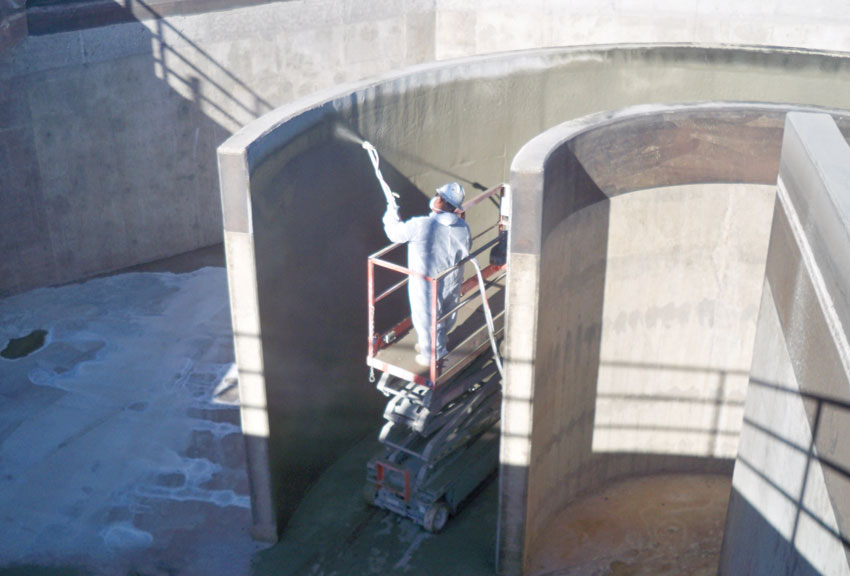
All images courtesy of XYPEX Chemical Corp.
Concrete structures that are subject to water, chemicals and other stresses can be enhanced by incorporating crystalline technology into their mix or as a spray-on application.
The Problem: Concrete Deterioration
Concrete is a mixture of natural ingredients and man-made processes. The particular ingredients used and their ratio in proportion to each other can create great variety and differences in the strength, appearance and functionality of concrete. Nonetheless, there are some fundamental characteristics of all concrete that are common—some of which help define its susceptibility to deterioration.
Typically, a concrete mix consists of about 60–75% aggregate (fine and coarse), 10–15% percent cement and 15–20% water. It is the water added to the dry materials that causes the chemical reaction of hydration, which allows the cement to hold all of the other materials together. Often, more water is used than is needed for hydration for the convenience of making the concrete easier to pour and form. This practice plus the mixing process can produce air pockets or bubbles that take up another 5–8% of the total mix. As the water is hydrated, drained or evaporated away, the cured concrete is left with a myriad of air gaps, holes, pores, capillary tracts and other internal voids. Further, concrete shrinks in size as it cures, although if it cured properly, that shrinkage can be kept to a minimum. Nonetheless, visible cracks or much less visible micro-cracks can occur. The end result is that while concrete may appear strong and impenetrable on the surface, it actually ends up quite porous due to the variety of openings and voids inherent within it. This porosity means that water can penetrate into and even through a concrete structure, giving it properties of permeability that are often not desirable.
The limitations of concrete are exhibited in several ways. First, the surface can be physically damaged due to physical force, abuse, weather, etc. Such physical damage can cause the surface of the concrete to crack or break, exposing the inner aggregate and creating a rough surface that is vulnerable to further deterioration. Secondly, when chemical substances penetrate beneath the surface of the concrete, they can interact with the concrete and cause damage or deterioration. The extent and nature of the damage will depend on the types of chemicals or other substances that penetrate into the concrete. Finally, the permeable nature of concrete can allow water and chemicals to penetrate and cause corrosion on any metal components embedded in the concrete. This includes reinforcing steel, anchors, sleeves, post supports, angles or any other metal that is used with concrete structures.
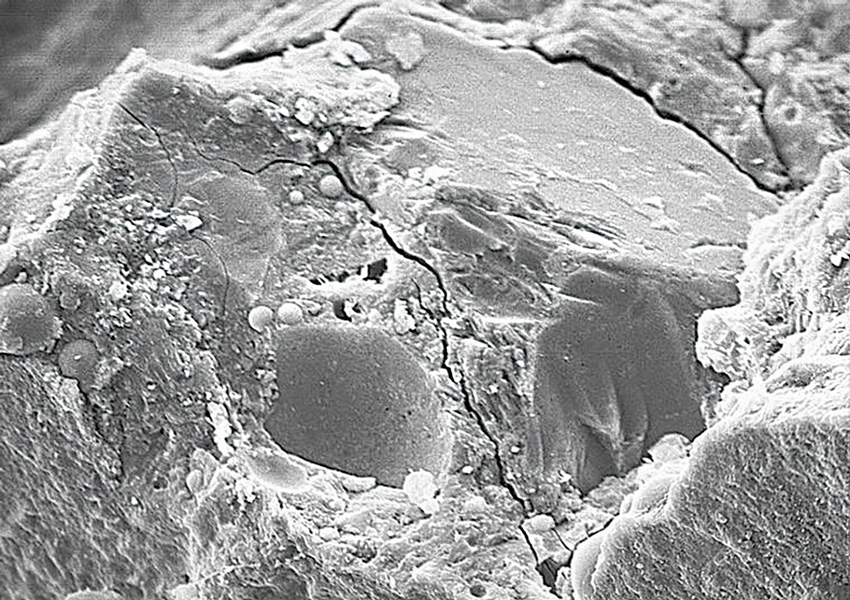
An electron microscopic magnified view of a micro-crack in concrete that can occur due to normal shrinkage.
Recognizing all of these issues, the Portland Cement Association (PCA) has investigated these phenomena in some depth and identified a number of specific types and causes of deterioration in concrete. Some of them are summarized below.
Abrasion/Erosion
Abrasion damage is caused by rubbing and friction against the outer paste of concrete, exposing the fine and coarse aggregate that will cause additional degradation. The two most common and damaging forms of abrasion occur on vehicular traffic surfaces and in hydraulic structures, such as dams, spillways, tunnels and even infrastructure piping. Traffic surface abrasion can be controlled by limiting the types of vehicles and tires that are used and selecting appropriately hard aggregate to withstand the weight and wear of vehicles.
Addressing abrasion damage in hydraulic structures is a bit more involved. High-quality concrete can resist water flowing over it, even at high velocities, for many years with little or no damage. However, concrete is susceptible to deterioration from the abrasive action of debris or solid materials in the water that grind or repeatedly impact on its surface. Spillway aprons, stilling basins, sluiceways, drainage conduits or culverts, and tunnel linings are particularly susceptible to this type of abrasion erosion. In hydraulic structures, it is readily recognized by a smooth, worn appearance on the surface of the concrete, suggesting that it can be reduced by using strong concrete with hard aggregates.
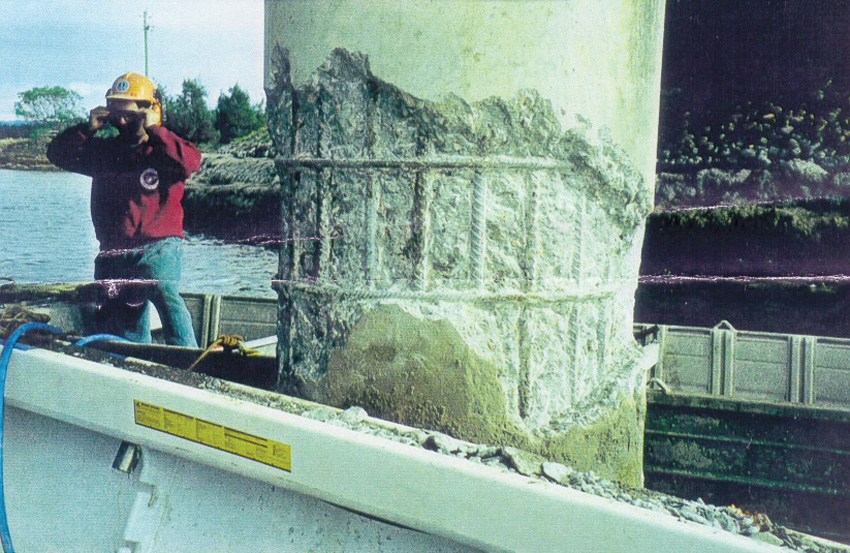
This concrete support has deteriorated due to abrasion and erosion in a tidal zone.
Freeze-Thaw Attack
When water freezes, it expands. If water seeps into concrete cavities, such as capillaries or pores, and then freezes, that expansion can produce pressure in the concrete. Once the pressure exceeds the tensile strength of the concrete, the cavities will burst. If those areas are small, then it may not be significant at first, but if that cycle is repeated over time through multiple events of water seepage, freezing and thawing, then significant cracking, scaling and crumbling of the concrete can occur. This phenomenon is important not only after the concrete is in place and cured but also during its placement. The common approach to improve the resistance of concrete against freezing is the use of intentionally entrained air. This creates more air voids in the concrete, which act as empty chambers for the freezing and migrating water to enter and expand into, thus relieving the pressure in the capillaries and pores and preventing damage to the concrete. A better solution is to create concrete with low permeability in the first place, which is better able to resist the penetration of water and, as a result, be less affected by freeze-thaw cycles.
A related freeze-thaw issue comes about when aggregates are used that can absorb water. If those aggregates reach critical saturation, they cannot accommodate the expansion and hydraulic pressure that occurs when water inside the aggregate freezes. The result is expansion of the aggregate and possible disintegration of the concrete. If this occurs near the surface of the concrete, it can cause a pop-out of a section of concrete and aggregate.
Shrinking and Cracking
As concrete cures, it changes slightly in volume, typically shrinking, but, in some cases, it can expand. The most common reasons for this change in volume comes from changes in moisture content or in temperature. If the concrete is restrained against volume changes, especially contraction, then the internal forces can cause cracking to occur. For example, since almost all concrete is mixed with more water than is needed to hydrate the cement, much of the remaining water evaporates. The surface of freshly placed concrete can be prone to shrinking if water evaporates faster than it is replaced by other water. Due to the restraint provided by the concrete below the drying surface layer, tensile stresses develop resulting in shallow cracks of varying depth. The common remedy is to prevent rapid water loss from the concrete surface by using fog nozzles, plastic sheeting, windbreaks and sunshades to prevent excessive evaporation.
Similarly, evaporation can reduce the volume of the curing concrete below the surface too, causing it to shrink as the concrete dries. Restraint to this shrinkage, from the subgrade, steel reinforcement or another part of the structure, creates tensile stresses in the hardened concrete. These stresses can lead to cracks of all sizes. In many applications, this drying shrinkage cracking is considered inevitable, which is why control joints are used to predetermine their location. Drying shrinkage can be limited by keeping the water content of concrete as low as possible and maximizing the coarse aggregate content.
Finally, cracking can occur in concrete due to thermal expansion when heated and contraction when cooled. Thermal expansion and contraction of concrete varies with factors such as aggregate type, cement content, water-cement ratio, temperature range, concrete age and relative humidity. Of these, aggregate type has the greatest influence. Designers should give special consideration to structures in which some portions of the structure are exposed to temperature changes, while other portions are partially or completely protected. Allowing for movement by using properly designed expansion or isolation joints and correct detailing will help minimize the effects of temperature variations.

Concrete is subject to chemical attack whenever it is used in conditions that create compounds that can interact with the chemicals of concrete.
Chemical Attack
Concrete is rarely, if ever, attacked by solid, dry chemicals. To produce a significant attack on concrete, aggressive chemicals must be in solution and above minimum concentration levels. Acids, for example, occur in liquid form and can react with the calcium hydroxide of hydrated portland cement. Sulfuric acid can form in the atmosphere from the mixture of sulfurous gases and water (acid rain) from the burning of fossil fuels and become a problem for concrete. Similarly, certain bacteria convert sewage into sulfuric acid, which is particularly aggressive to concrete because it reacts with portland cement to form calcium sulfate, which deteriorates concrete. Sulfates attack concrete by reacting with hydrated compounds in the hardened cement. These reactions can induce sufficient pressure to disrupt the cement paste, resulting in loss of cohesion and loss of strength.
Naturally occurring sulfates of sodium, potassium, calcium or magnesium in soil or groundwater can also cause sulfate attack on concrete. When water laden with these chemical compounds evaporates, sulfates can be left behind to accumulate on the concrete surface, increasing in concentration and their potential for causing deterioration. Seawater also contains sulfates but is not as severe an exposure as sulfates in groundwater. Of course, environmental conditions have a great influence on sulfate attack, with the greatest concerns present when concrete is exposed to wet/dry cycling.
To prevent deterioration from acid attack, portland cement concrete generally must be protected from acidic environments either with surface protective treatments or by selecting concrete mixes that are somewhat acid resistant. Resistance to sulfates in concrete is typically achieved by using a low water-to-cement ratio and a cement with a limited amount of tricalcium aluminates. Calcium chloride reduces sulfate resistance so it should not be used as an accelerating admixture in concrete exposed to severe sulfate environments. However, since liquid penetration is the issue, creating concrete with less permeability can also produce less deterioration from acid or sulfate attacks.
Salts and alkalis can also be problematic for concrete. Specifically, the chloride and nitrate salts of ammonium, magnesium, aluminum and iron all cause concrete deterioration. Ammonium salts are the most destructive because, in the alkaline environment of concrete, they release ammonia gas and hydrogen ions. These are replaced by dissolving calcium hydroxide from the concrete. The result is a leaching action, much like acid attack. Salts suspended in water can also crystallize in porous concrete and cause weathering damage, particularly in the form of sodium carbonate and sodium sulfate. Under drying conditions, salt solutions can rise to the surface by capillary action and, as a result of surface evaporation, the solution phase becomes supersaturated and salt crystallization occurs, sometimes generating pressures large enough to cause cracking and scaling.
Alkalis can be an issue with some aggregates too. In most concrete, aggregates are more or less chemically inert, but some react with the alkali hydroxides in concrete, creating alkali aggregate reactions (AAR). Those reactions can cause expansion and cracking over a period of years. The most typical of these is an alkali-silica reaction because aggregates containing reactive silica materials are more common. Aggregates containing certain forms of silica will react with alkali hydroxide in concrete to form a gel that swells as it draws water from the surrounding cement paste or the environment. In absorbing water, these gels can swell and induce enough expansive pressure to damage concrete.
Typical indicators of alkali-silica reactivity are map (random pattern) cracking and, in advanced cases, closed joints and spalled concrete surfaces. Because sufficient moisture is needed to promote destructive expansion, alkali-silica reactivity can be significantly reduced by keeping the concrete as dry as possible. In fact, the reactivity can be virtually stopped if the internal relative humidity of the concrete is kept below 80%.

Chloride ions that penetrate concrete and cause reinforcing steel to oxidize or rust can lead to significant deterioration of the concrete as the steel expands and creates stress on the concrete.
Corrosion of Reinforcing Steel
Corrosion of reinforcing steel and other embedded metals is the leading cause of deterioration in concrete. The corrosion occurs when the iron that is integral to steel reacts with oxygen to create iron oxide, or rust. If this happens inside concrete, the corroding rust expands to occupy a greater volume than the steel. This expansion creates tensile stresses in the concrete, which can eventually cause cracking, delamination and spalling.
Exposure of reinforced concrete to chloride ions, commonly found in deicing salts and seawater, is the primary cause of premature corrosion of steel reinforcement. No other contaminant is documented as extensively in the literature as a cause of corrosion of metals in concrete. Chlorides dissolved in water can permeate through concrete pores or reach the steel through cracks. Chloride-containing admixtures can also cause corrosion. The risk of corrosion increases directly as the chloride content of concrete increases. However, only water-soluble chlorides promote corrosion; some acid-soluble chlorides may be bound within aggregates and, therefore, are unavailable to promote corrosion. The primary factors are the availability of oxygen, the pH level, the temperature and the relative humidity of the concrete. Corrosion of embedded metals in concrete can be greatly reduced by first providing an adequate thickness of concrete cover over the reinforcing steel. An even stronger defense involves creating low-permeability concrete to reduce the likelihood of water containing chloride ions from ever reaching the steel to begin with. Eliminating or filling cracks is part of assuring low permeability.
Another source of steel corrosion can also deteriorate the surface of the concrete first. Carbon monoxide (CO) and carbon dioxide (CO2) in the atmosphere are the gasses responsible for the corrosive phenomenon known as ‘carbonation.’ This is a process that creates a corrosive condition that softens the surface layers of the concrete. It occurs when carbon dioxide from the air penetrates the concrete and reacts with hydroxides, such as calcium hydroxide, to form carbonates, specifically calcium carbonate. This reaction reduces the pH of the concrete and in turn directly affects the ability of the concrete to protect steel reinforcing in part because carbonation of concrete lowers the amount of chloride ions needed to promote corrosion. In new concrete with a pH of 12 to 13, about 7,000 to 8,000 ppm of chlorides are required to start corrosion of embedded steel. If, however, the pH is lowered to a range of 10 to 11, then the chloride threshold for corrosion is significantly lower—at or below 100 ppm or less than 1.5% of what would be required otherwise.
Carbonation is generally a slow process, but the amount of carbonation is significantly increased in concrete with a high water-to-cement ratio, low cement content, short curing period, low strength and highly permeable or porous paste. Further, carbonation is highly dependent on the relative humidity of the concrete. The highest rates of carbonation occur when the relative humidity is maintained between 50% and 75%, while below 25% relative humidity, the degree of carbonation is considered insignificant. Hence it makes sense that carbonation-induced corrosion often occurs in humid locations, such as areas of building facades that are exposed to rainfall or shaded from sunlight. Reducing the permeability of the concrete will again help combat the reactions needed for carbonation to occur.
The Solution: Chemistry
Each of the causes of concrete deterioration that we have discussed can produce aesthetic, functional or structural problems if not treated properly or addressed ahead of time. To overcome these problems, there are several approaches. A common one is to use a surface coating in response to the need to waterproof the concrete to keep not just water out but chemicals and other substances too. Such solutions are based on applying a protective coating over the concrete after it is fully cured. While there are certainly some good and well-known products available for this, with the exception of crystalline technology coatings, their inherent limitation is that they are not integral to the concrete—they are all an applied layer on top of it. This means their success is entirely dependent on their adhesion to the concrete surface to prevent it from separating and peeling off, leaving the concrete exposed. They also require ongoing maintenance to be sure that the coating remains intact and continues to protect the concrete over time.
Chemical admixtures are another approach to address the properties and capabilities of concrete. They are an integral solution generally regarded as a superior approach that has been used for decades to improve the performance of concrete in a variety of ways. Their first widespread use was to extend the temperature range that concrete could be poured without fear of freezing. They also became common to improve the workability of concrete through plasticizers that allowed less water in the mix, while still retaining adequate slump (formability). Building on this proven success, it is possible to combine careful attention to the mix of concrete ingredients with appropriate chemical admixtures that can yield solutions to overcome deterioration challenges. This is particularly true through the use of admixtures that employ crystalline technology to achieve some impressive results.

A scanning electron microscope image of crystalline formation in a concrete pore shows its ability to fill and plug the voids inherent in concrete.
Crystalline Technology: What It Is and How It Works
Crystalline technology takes advantage of the natural and porous characteristics of concrete. With water as the catalyst, specific chemicals are used that react with the natural by-products of cement hydration (calcium hydroxide, mineral salts, mineral oxides, and unhydrated and partially hydrated cement particles). This reaction forms a nonsoluble crystal that grows to form a web-like crystalline structure within the interconnected pores and other voids in concrete. In this way, the crystalline structure becomes a permanent, integral part of the concrete itself. Because it is nonsoluble, it fills the voids, cracks, capillaries, pores and other openings to make the concrete impermeable, thus preventing the ingress of water and other liquids even under strong hydrostatic pressure. That means it also protects against liquid-borne chemicals that can deteriorate concrete or corrode steel reinforcing, even in harsh, aggressive environments.
When a cement particle hydrates, the reaction between water and the cement causes it to become a hard, solid, rocklike mass. The reaction also generates chemical by-products that lie dormant in the concrete. Crystalline technology adds another set of chemicals to the mixture. When these two groups, the by-products of cement hydration and the crystalline chemicals, are brought together in the presence of moisture, a chemical reaction occurs, which produces a new nonsoluble structure in the capillaries, micro-cracks and shrinkage cracks that are found in the concrete. By means of the crystalline reaction, the porosity of the concrete is plugged, and the ability of water or water-borne chemicals to penetrate the substrate is prevented.
Integral crystalline technology products are manufactured in the form of a dry powder compound consisting of portland cement, very fine treated silica sand and selected chemicals. It is the chemicals that react with the by-products of cement hydration to produce the nonsoluble crystalline formation. Specific formulations are produced for application either as a coating material, concrete admixture or dry shake product. It can be incorporated into a structure as it is being constructed or later on in the life cycle as a maintenance material that will further enhance its durability.
Crystalline Technology: What It Does
Scanning electron microscope images have provided a closeup view of how newly formed crystalline structures bridge and seal the capillary tracts and cracks in concrete. This directly reduces the diffusion of liquids and aggressive substances into the concrete and significantly extends the life of the structure. As such, crystalline technology has been shown to provide the following characteristics:

The integral capabilities of crystalline technology mean that the entire concrete structure is protected and made resistant to water and other penetrating substances.
- Provides Integral Concrete Waterproofing: Crystalline technology is an integral solution for reducing the permeability of concrete. When it reacts with the by-products of cement hydration to produce a nonsoluble crystalline structure, it blocks up the voids, openings, and other paths or passages that define the typical porosity of concrete. By plugging the pores, capillary tracts and micro-cracks with a crystalline formation, the diffusion of liquids and gases is significantly reduced, thus protecting concrete structures against effects of water penetration, including freeze-thaw cycles and water borne chemical attacks. Further, since all causes of deterioration need these paths and passages in order to diffuse into the concrete, their blockage defends against other attacks as well.
- Resists Acid Attacks: Concrete can be attacked by acidic or caustic materials, as we have seen. Acids in liquid form attack concrete by penetrating the concrete through its inherent capillary porosity as well as micro- and macro-cracks. Once inside concrete, the acid reacts with calcium hydroxide to form a calcium salt, which is easily separated from the cement resulting in a weakened paste structure. Once all of the calcium hydroxide is consumed, the acid will then attack the calcium silicate hydrate, which is the true cementing mechanism holding all of the aggregates together, and this can cause substantial structural damage to concrete. By using crystalline technology to block up the capillaries and pores of the concrete to begin with, these acidic chemical reactions and deterioration of concrete are significantly reduced.
- Resists Sulfate Attacks: Similarly, by using crystalline technology to waterproof the concrete and decrease its permeability, the amount of sulphate ions that can diffuse into the pores of the concrete is greatly diminished. When the sulphates are restricted from entering the concrete, sulphate attack is reduced, while the resistance and durability of the concrete is increased. It is also worth remembering here that the reactive chemicals in crystalline technology combine with various calcium compounds in the concrete. These calcium compounds are given off as by-products of cement hydration and are a primary building block for sulphate corrosion. By reacting with calcium hydroxide and turning it into a nonsoluble complex, the crystalline technology limits the amount of free CH available for the initial sulphate reaction. This has a direct effect on reducing the rest of the sulphate corrosion process.
- Inhibits the Effects of Carbonation: Crystalline formation in the capillary tracts has been shown to reduce not only water but also the flow of gases into concrete. Since carbonation is dependent on CO and CO2 penetrating the surface of the concrete, particularly in humid applications, crystalline technology significantly retards the carbonation process.
- Reduces Chloride Ion Attacks: A common problem for marine structures, bridges and concrete structures along roadways in cold climates is chloride attack, which occurs when chloride ions reach the steel reinforcement via interconnected pores and cracks in the concrete. Once the chloride ions have reached a critical concentration level, they are able to break down the naturally passivating alkaline film surrounding the steel and form an electrochemical corrosion cell. This results in the breakdown of the steel and the formation of rust, which occupies a larger volume than the original steel and ultimately weakens the structure. Crystalline waterproofing has been shown to reduce the diffusion of chlorides in concrete structures by preventing liquids carrying chloride ions from ever reaching the steel. This helps protect reinforcing steel and prevents deterioration that could occur from oxidation and expansion of steel reinforcement.
Crystalline Technology Performance
With an understanding of the principles and characteristics behind protecting concrete through crystalline technology, it is worth looking at how it has actually performed based on tests and studies carried out by independent bodies. Some representative results are summarized as follows:

The University of Wisconsin at Milwaukee conducted a series of field-testing studies and determined that this bridge treated with crystalline technology showed dramatically reduced chloride content compared with control structures.
- Chloride Resistance Performance: Testing carried out at the University of New South Wales, Australia by the Australian Centre of Construction Innovation demonstrated that concrete integrally treated with crystalline technology reduced the diffusion of chloride ions. The specific performance was such that calculations based on estimated service life showed a doubling of the expected time to corrosion when compared to an untreated control mix. A separate effort at the University of Wisconsin-Milwaukee was based on field testing of nine bridges that had been treated with various corrosion mitigation strategies, including surface sealers and three different admixtures. At a 2-in. depth, the crystalline technology-treated bridge section showed an average 55% reduction in chloride content as compared with the control section, indicating a very strong level of protection.
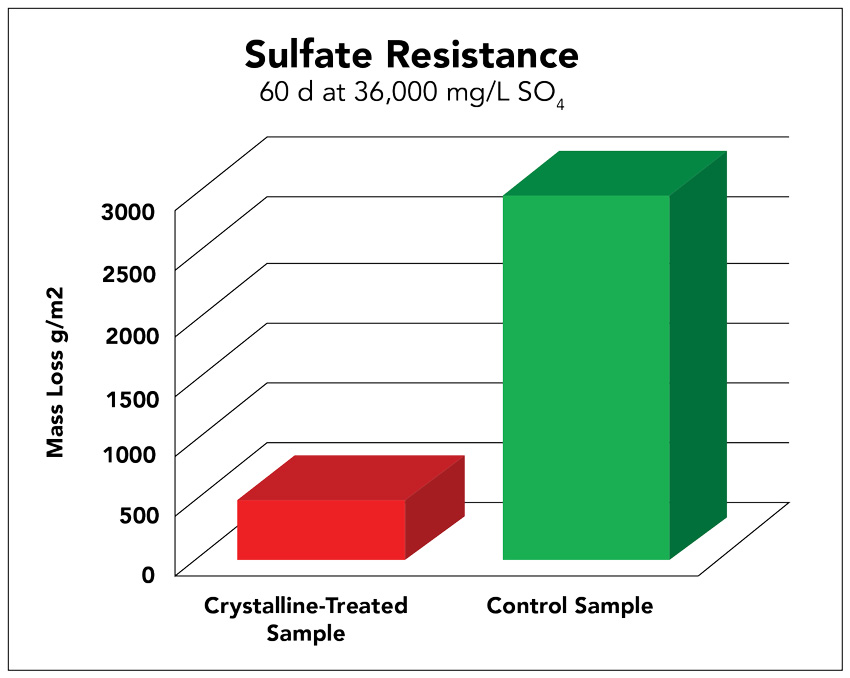
Test results have shown that crystalline technology dramatically decreases the amount of sulfate that penetrates into concrete.
- Sulfate Resistance Performance: Testing has shown that concrete that has been treated with crystalline technology has an enhanced resistance to chemicals where the pH range is from 3 to 11 in constant contact and 2 to 12 in periodic contact. Both sets were subjected to a solution of 5% H2SO4 (pH 0.7) for 100 days. The crystalline technology treatment suppressed the erosion of the concrete mortar to 1/8 that of the untreated specimens. Testing for sulphate resistance per AS2350-14 showed the beneficial effect of crystalline technology on both fly ash and slag cement concretes, with reductions in sulphate expansion ranging from 27% to 58%.
- Overall Durability: In addition to visual evidence of the effect of the crystals in the form of electron microscope images, both independent permeability and chemical resistance studies attest to the ability of crystalline technology to greatly extend concrete structure service life.
Crystalline-Treated Concrete and Sustainability
The biggest sustainable result of using crystalline technology in concrete is increased durability and longevity of concrete structures. That longevity means there is likely less maintenance and repair work, and less need to replace a damaged or deteriorating structure. Less repair and replacement means less need for new materials and energy to create more concrete. All of this leads to dramatically improved sustainability compared to conventional, porous and permeable concrete.

Concrete that incorporates crystalline technology is more durable and sustainable whether used for buildings, infrastructure or other purposes.
The best method used to determine the degree of sustainability of any material is to conduct a life-cycle assessment that addresses extraction of raw materials, transporting them, processing them (particularly with energy), incorporating them into structures and finally recovering them at the end of the service life of the structure for either recycling, reuse or disposal. National and international standards have been developed for conducting, such a life-cycle assessment that begin with product category rules (PCRs) for a particular type of material or product. ASTM International has produced just such a document for assessing cement, known as UN CPC 3744: Portland, Blended Hydraulic, Masonry, Mortar, and Plastic (Stucco) Cements. This document can be used by cement manufacturers to produce an environmental product declaration (EPD) that identifies the specific environmental impacts of their product. Those impacts are presented in terms of environmental, energy and material/waste effects from using the product. By requesting EPDs from different cement manufacturers and comparing the results, engineers and others can determine the differences in the short- and long-term environmental impacts of those products. Many who have looked at portland cement, concrete and sustainability have determined that the long-term benefits of the material can be shown to outweigh initial impacts of producing it, thus producing a more favorable life-cycle assessment.
Integral waterproofing using crystalline technology goes beyond the normal EPD criteria in that it protects concrete against water and chemical intrusion, thus enhancing durability and lengthening the life of concrete structures. It can also eliminate the need for separate membranes that may have characteristics that lead to concern over their environmental or human health impacts. Altogether, concrete, particularly durable crystalline technology concrete, can contribute to green and sustainable structure designs in several ways.
In site work projects, durable concrete that can control or resist water will hold up better and provide better functionality than concrete that is prone to deterioration. Concrete that is prone to wet conditions is a particular concern that can be addressed with crystalline technology. Further, concrete pavers that are designed to allow rainwater to percolate into the soil naturally helps to promote better drainage for more sustainable sites. If concrete is used in buildings with conditioned spaces, it can provide thermal mass which, when designed appropriately, can improve overall energy performance.
Regardless of the project type, many concrete mixes incorporate recycled or reclaimed materials as substitutes for stone aggregates. This avoids new material extractions and all of the environmental and energy impacts associated with them. In particular, the use of fly ash or slag in concrete mixes has been seen as a positive way to harvest and neutralize some otherwise problematic products of coal combustion and steel production. These can provide desirable substitutes for aggregate and even for some cement depending on the chemical makeup. Crystalline technology has been used successfully in these mix formulations with similarly impressive performance results. Further, embedding these materials into concrete structures for a useful purpose removes them from stockpiles that have the potential for damaging the environment.
Locally produced materials and products are another hallmark of sustainability that makes sense here. Concrete ingredients and mixes by their nature are best produced locally. This not only helps control the cost of transporting heavy materials, it also reduces the energy used in transporting them. Less energy used means less environmental impact. Based on all of these attributes and a full life-cycle assessment, architects, engineers, cement manufacturers, concrete mix companies and construction operations can all address green and sustainable attributes of projects by selecting the most appropriate cement and concrete formulations.
Conclusion
Durability of concrete depends on many factors, but perhaps the most significant is the porosity and permeability of concrete. The diffusion rate of aggressive substances is controlled by lowering the permeability of concrete. Lower permeability makes it more difficult for water and corrosive agents to penetrate the concrete. Crystalline technology has been demonstrated and well documented to turn concrete into a waterproof material that will resist many common causes of deterioration and corrosion. Multiple test results have demonstrated that crystalline technology significantly enhances the quality and watertightness of concrete, particularly in extreme exposure conditions.
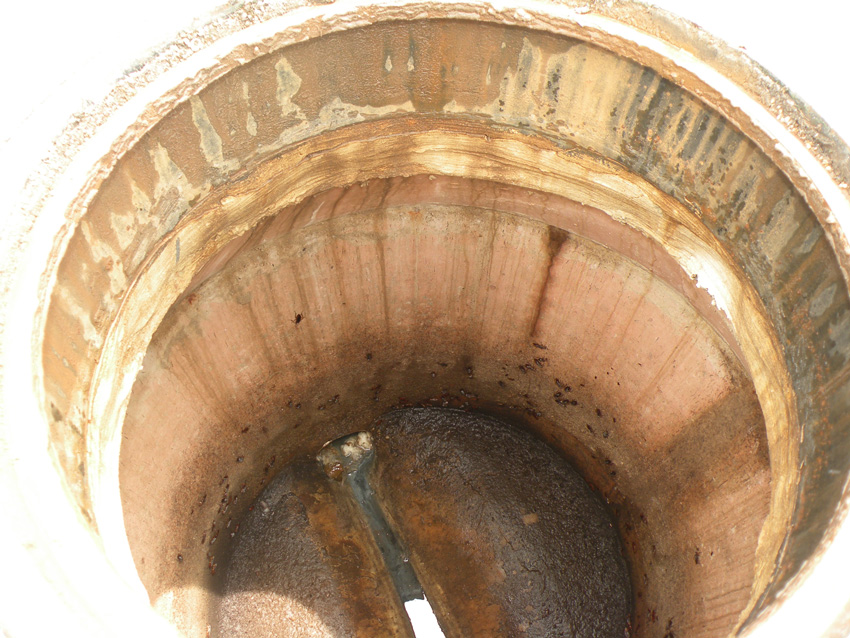
Concrete products have been enhanced using the proven performance of crystalline technology.
Peter J. Arsenault, FAIA, NCARB, LEED AP, is a nationally known architect, sustainability consultant, technical writer and continuing education presenter who has authored more than 140 continuing education articles. www.linkedin.com/in/pjaarch
 |
XYPEX Chemical Corp. is a manufacturer of crystalline waterproofing materials with an international network of distributors and licensees in more than 70 countries. XYPEX products have been specified and applied on thousands of major concrete structures around the world. www.xypex.com
|















